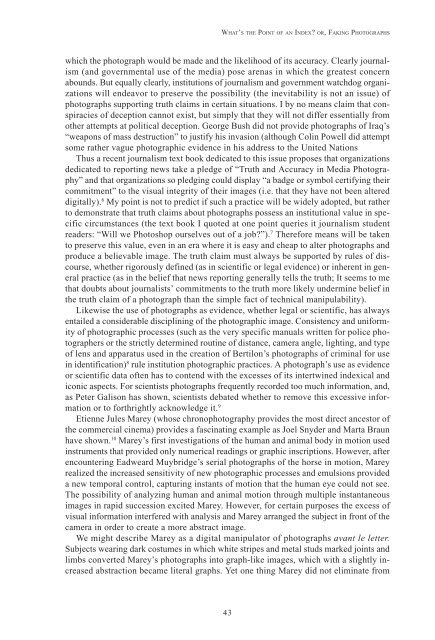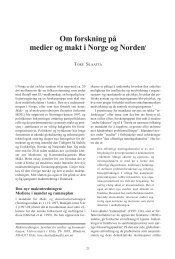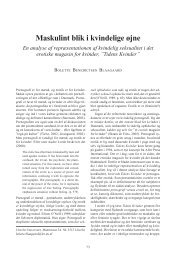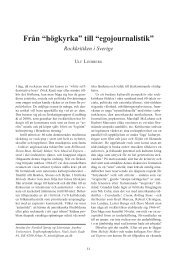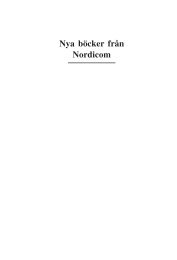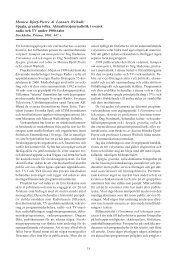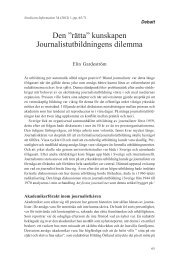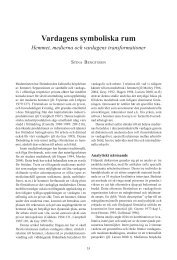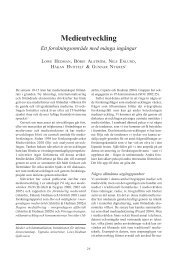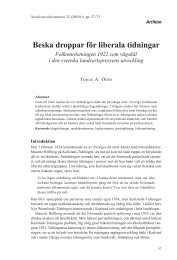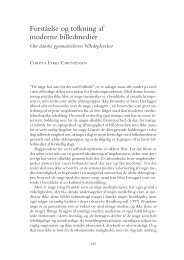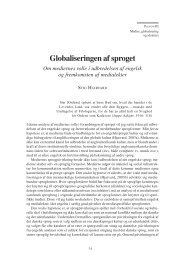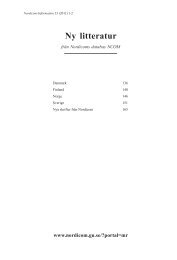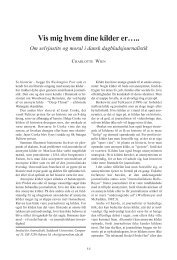What's the Point of an Index? or, Faking Photographs - Nordicom
What's the Point of an Index? or, Faking Photographs - Nordicom
What's the Point of an Index? or, Faking Photographs - Nordicom
Create successful ePaper yourself
Turn your PDF publications into a flip-book with our unique Google optimized e-Paper software.
WHAT’S THE POINT OF AN INDEX? OR, FAKING PHOTOGRAPHS<br />
which <strong>the</strong> photograph would be made <strong>an</strong>d <strong>the</strong> likelihood <strong>of</strong> its accuracy. Clearly journalism<br />
(<strong>an</strong>d governmental use <strong>of</strong> <strong>the</strong> media) pose arenas in which <strong>the</strong> greatest concern<br />
abounds. But equally clearly, institutions <strong>of</strong> journalism <strong>an</strong>d government watchdog <strong>or</strong>g<strong>an</strong>izations<br />
will endeav<strong>or</strong> to preserve <strong>the</strong> possibility (<strong>the</strong> inevitability is not <strong>an</strong> issue) <strong>of</strong><br />
photographs supp<strong>or</strong>ting truth claims in certain situations. I by no me<strong>an</strong>s claim that conspiracies<br />
<strong>of</strong> deception c<strong>an</strong>not exist, but simply that <strong>the</strong>y will not differ essentially from<br />
o<strong>the</strong>r attempts at political deception. Ge<strong>or</strong>ge Bush did not provide photographs <strong>of</strong> Iraq’s<br />
“weapons <strong>of</strong> mass destruction” to justify his invasion (although Colin Powell did attempt<br />
some ra<strong>the</strong>r vague photographic evidence in his address to <strong>the</strong> United Nations<br />
Thus a recent journalism text book dedicated to this issue proposes that <strong>or</strong>g<strong>an</strong>izations<br />
dedicated to rep<strong>or</strong>ting news take a pledge <strong>of</strong> “Truth <strong>an</strong>d Accuracy in Media Photography”<br />
<strong>an</strong>d that <strong>or</strong>g<strong>an</strong>izations so pledging could display “a badge <strong>or</strong> symbol certifying <strong>the</strong>ir<br />
commitment” to <strong>the</strong> visual integrity <strong>of</strong> <strong>the</strong>ir images (i.e. that <strong>the</strong>y have not been altered<br />
digitally). 6 My point is not to predict if such a practice will be widely adopted, but ra<strong>the</strong>r<br />
to demonstrate that truth claims about photographs possess <strong>an</strong> institutional value in specific<br />
circumst<strong>an</strong>ces (<strong>the</strong> text book I quoted at one point queries it journalism student<br />
readers: “Will we Photoshop ourselves out <strong>of</strong> a job?”). 7 Theref<strong>or</strong>e me<strong>an</strong>s will be taken<br />
to preserve this value, even in <strong>an</strong> era where it is easy <strong>an</strong>d cheap to alter photographs <strong>an</strong>d<br />
produce a believable image. The truth claim must always be supp<strong>or</strong>ted by rules <strong>of</strong> discourse,<br />
whe<strong>the</strong>r rig<strong>or</strong>ously defined (as in scientific <strong>or</strong> legal evidence) <strong>or</strong> inherent in general<br />
practice (as in <strong>the</strong> belief that news rep<strong>or</strong>ting generally tells <strong>the</strong> truth; It seems to me<br />
that doubts about journalists’ commitments to <strong>the</strong> truth m<strong>or</strong>e likely undermine belief in<br />
<strong>the</strong> truth claim <strong>of</strong> a photograph th<strong>an</strong> <strong>the</strong> simple fact <strong>of</strong> technical m<strong>an</strong>ipulability).<br />
Likewise <strong>the</strong> use <strong>of</strong> photographs as evidence, whe<strong>the</strong>r legal <strong>or</strong> scientific, has always<br />
entailed a considerable disciplining <strong>of</strong> <strong>the</strong> photographic image. Consistency <strong>an</strong>d unif<strong>or</strong>mity<br />
<strong>of</strong> photographic processes (such as <strong>the</strong> very specific m<strong>an</strong>uals written f<strong>or</strong> police photographers<br />
<strong>or</strong> <strong>the</strong> strictly determined routine <strong>of</strong> dist<strong>an</strong>ce, camera <strong>an</strong>gle, lighting, <strong>an</strong>d type<br />
<strong>of</strong> lens <strong>an</strong>d apparatus used in <strong>the</strong> creation <strong>of</strong> Bertilon’s photographs <strong>of</strong> criminal f<strong>or</strong> use<br />
in identification) 8 rule institution photographic practices. A photograph’s use as evidence<br />
<strong>or</strong> scientific data <strong>of</strong>ten has to contend with <strong>the</strong> excesses <strong>of</strong> its intertwined indexical <strong>an</strong>d<br />
iconic aspects. F<strong>or</strong> scientists photographs frequently rec<strong>or</strong>ded too much inf<strong>or</strong>mation, <strong>an</strong>d,<br />
as Peter Galison has shown, scientists debated whe<strong>the</strong>r to remove this excessive inf<strong>or</strong>mation<br />
<strong>or</strong> to f<strong>or</strong>thrightly acknowledge it. 9<br />
Etienne Jules Marey (whose chronophotography provides <strong>the</strong> most direct <strong>an</strong>cest<strong>or</strong> <strong>of</strong><br />
<strong>the</strong> commercial cinema) provides a fascinating example as Joel Snyder <strong>an</strong>d Marta Braun<br />
have shown. 10 Marey’s first investigations <strong>of</strong> <strong>the</strong> hum<strong>an</strong> <strong>an</strong>d <strong>an</strong>imal body in motion used<br />
instruments that provided only numerical readings <strong>or</strong> graphic inscriptions. However, after<br />
encountering Eadweard Muybridge’s serial photographs <strong>of</strong> <strong>the</strong> h<strong>or</strong>se in motion, Marey<br />
realized <strong>the</strong> increased sensitivity <strong>of</strong> new photographic processes <strong>an</strong>d emulsions provided<br />
a new temp<strong>or</strong>al control, capturing inst<strong>an</strong>ts <strong>of</strong> motion that <strong>the</strong> hum<strong>an</strong> eye could not see.<br />
The possibility <strong>of</strong> <strong>an</strong>alyzing hum<strong>an</strong> <strong>an</strong>d <strong>an</strong>imal motion through multiple inst<strong>an</strong>t<strong>an</strong>eous<br />
images in rapid succession excited Marey. However, f<strong>or</strong> certain purposes <strong>the</strong> excess <strong>of</strong><br />
visual inf<strong>or</strong>mation interfered with <strong>an</strong>alysis <strong>an</strong>d Marey arr<strong>an</strong>ged <strong>the</strong> subject in front <strong>of</strong> <strong>the</strong><br />
camera in <strong>or</strong>der to create a m<strong>or</strong>e abstract image.<br />
We might describe Marey as a digital m<strong>an</strong>ipulat<strong>or</strong> <strong>of</strong> photographs av<strong>an</strong>t le letter.<br />
Subjects wearing dark costumes in which white stripes <strong>an</strong>d metal studs marked joints <strong>an</strong>d<br />
limbs converted Marey’s photographs into graph-like images, which with a slightly increased<br />
abstraction became literal graphs. Yet one thing Marey did not eliminate from<br />
43


